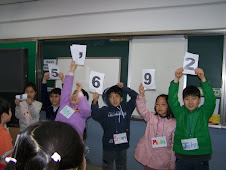These are various assessments I used throughout my teaching. Some were formal and some were informal.

The first one is a picture of the students holding up numbers. This was for my first lesson I taught on “Place Value”. In this activity the students were all given numbers and I would call out a phrase such as “I need a 2 in the ones place” and any student who had a number 2 would race up to the front of the classroom and get in the correct position. This activity allowed me to informally assess the students’ understanding of both English numbers and the location of place value. After the full number was created, together as a class we would read the number. For example in the picture shown the students would read the number as fifteen thousand, six hundred, ninety-two. This activity went extremely well and I was able to see that the students all understood the locations of the different place values as well as the names of English numbers. In addition, the students really enjoyed this activity and were excited to participate. I also like how it got the students involved and out of their seats. The lesson I observed of the Korean teachers usually had the students stay at their desks and just listen to the teacher lecture and watch him/her write on the board.

The second picture is from the same lesson on place value, but is a different activity. In this activity I wrote a number on the board such as “25,678”. I would then have two students sit in front of the board where there were several different numbers written. Each student would be given a flyswatter to use to identify the value I call. I would then say a phrase such as, “What is the value of the 6?” The students with the flyswatters would then find the “600” written on the board and hit it with their flyswatter. This activity allowed me to assess the students’ understanding of the place value and the worth of the number in each place value position. I like this activity because every student was given the opportunity to show their understanding two times because we went in order of the rows. Unlike the first activity where only the students who were quickest to get up to the board to display their numbers were able to show their understanding, this activity required every student to participate at least two times.

The third picture shows a group of students playing a memory game that I used in my lesson on Multiplication Properties. In this activity the students worked in groups of four and played a game of memory where they had to match multiplication equations to one of the four types of multiplication properties. During this activity I walked around the classroom and observed the students. In addition after the students matched all of the cards, they had to call me over and I would check their matched to make sure they were correct. This was a good way of informally assessing the students abilities to identify the properties when look at an equation. I think this activity was very successful. However, since the words were completely new to the students I left the notes on the board for them to use as reference, so I was able to assess if the students could remember the different types without having other equations from each property to use as a reference.

The fourth picture is a photo of a student’s creation of the three types of triangles from my triangle lesson plan. With this activity the students used straws and/or toothpicks to create the three types of triangles and write the names of the triangles. I collected all of these from each of my classes and graded them individually. I was impressed with the students’ work. Many of the students even wrote the names of the types of triangles in both English and Korean on their papers. This helped me to see that they truly understood what I had taught them because they could show their understanding by using what they had previously learned from their Korean teachers. The one issue with this assessment that I noticed was that sometimes it was difficult to tell if the students had created a scalene triangle or an isosceles because the lengths of the sides were not exact and hard to distinguish if the sides were equal. I think this assessment could have been improved by having the students measure and write the measurements of the sides or create larger representations which would show the difference in the lengths much more clearly.
I also have a variety of worksheets and quizzes that I have given the students and have student samples of. However, currently I don't have access to a scanner and when I take a picture of the page it is really blurry. I also don't know if it is possible to upload the original document from microsoft word so you can at least see a blank copy, but I will try to find out and add more of my assessments soon. I will also see if I can find a scanner to scan actual student samples to add to this blog as well.


No comments:
Post a Comment